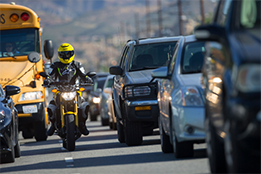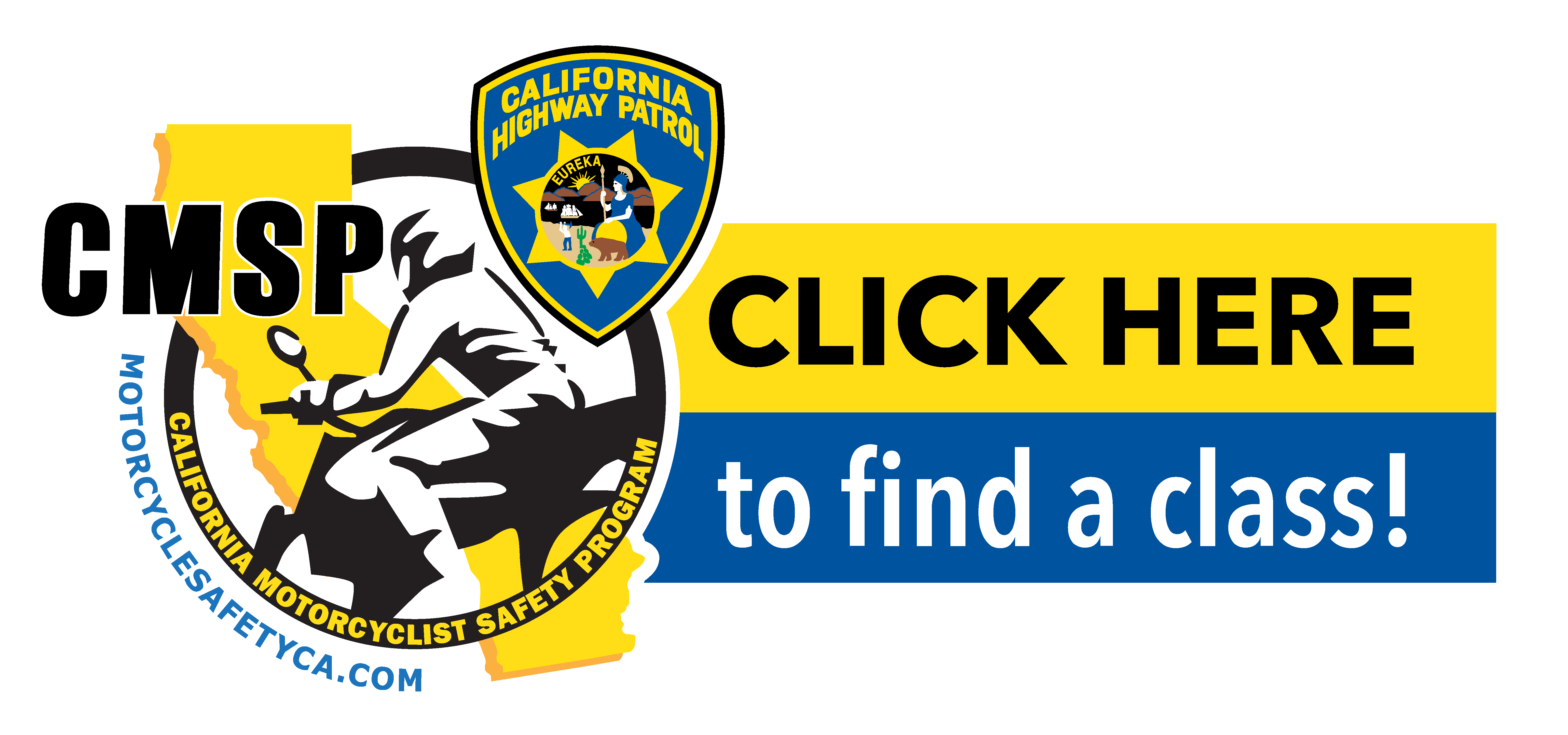California Motorcyclist Safety
CALIFORNIA MOTORCYCLIST SAFETY PROGRAM (CMSP)
The California Highway Patrol (CHP) is statutorily responsible for California's official motorcyclist safety and training program. Pursuant to California Vehicle Code Sections 2930-2935, the CHP administers the CMSP through a primary contractor, currently Total Control Training Inc. As of June of 2025, over 1,500,000 motorcycle riders have received training at one of the CMSP's many training sites since the program began in July 1987.
Two Ways To Be Safe & Learn The Latest Skills
The Motorcyclist Training Course (MTC) is a 15 hour course which includes 5 hours of classroom instruction and 10 hours of actual riding. The MTC is mandatory for those under the age of 21, but is also recommended to those 21 and older who are seeking to obtain a motorcycle endorsement on their California driver license.
The CMSP also offers the Premier Program which is an extended MTC consisting of 7.5-hours of classroom and 13.5-hours of riding. The CHP and its partners encourage all riders to be life-long learners and seek additional training beyond the MTC and Premier programs.
Benefits of Taking The Course:
- Upon completion you'll get a skills waiver that allows you to skip the riding skills test at the DMV
- Passing the class could result in insurance breaks
- It will give you and your family peace of mind
The California Highway Patrol (CHP) strongly encourages all motorcycle riders to sign up for a California Motorcyclist Safety Course, which is administered by the CHP as California's official motorcycle safety and training program.
Strategic Highway Safety Plan
The CHP Motorcycle Safety Unit (MSU) Unit is responsible for co-leading and participating in a dedicated challenge area. The MSP Unit is in the process of developing action items in collaboration with its partners including the traffic safety stakeholders, Department of Motor Vehicles, California Department of Transportation, and the Office of Traffic Safety (OTS).
California Motorcycle-Involved Statistics
Statewide Integrated Traffic Records System data indicates that motorcyclist fatalities in California have increased yearly. These increases in motorcyclist deaths have occurred at a time when significant gains were achieved in other areas of traffic safety. Motorcyclists are over represented in the overall numbers of traffic deaths in California.
Motorcycle Safety Information
Lane Splitting
Effective January 1, 2017, section 21658.1 was added to the California Vehicle Code and defines lane splitting. The following is section 21658.1 in its entirety:
21658.1 (a) For the purposes of this section, “lane splitting” means driving a motorcycle, as defined in Section 400, that has two wheels in contact with the ground, between rows of stopped or moving vehicles in the same lane, including on both divided and undivided streets, roads, or highways.
(b) The Department of the California Highway Patrol may develop educational guidelines relating to lane splitting in a manner that would ensure the safety of the motorcyclist and the drivers and passengers of the surrounding vehicles.
(c) In developing guidelines pursuant to this section, the department shall consult with agencies and organizations with an interest in road safety and motorcyclist behavior, including, but not limited to, all of the following 
(1) The Department of Motor Vehicles.
(2) The Department of Transportation.
(3) The Office of Traffic Safety.
(4) A motorcycle organization focused on motorcyclist safety.
Motorcycle Lane Splitting Safety Tips:
Lane Splitting Safety Tips DISCLAIMER
Lane splitting can be dangerous and extreme caution should be exercised. It should not be performed by inexperienced riders. The risk of death or serious injury during a lane splitting collision increases as speed and speed differential increases. These general safety tips are provided to assist you in the practice; however, they are not guaranteed to keep you safe. Every rider has the ultimate responsibility for their own decision-making and safety.
Lane Splitting Safety Tips for Motorcyclists
- Consider the total environment when you are lane splitting (this includes the width of lanes, the size of surrounding vehicles, as well as current roadway, weather, and lighting conditions).
- Danger increases at higher speed differentials.
- Danger increases as overall speed increases.
- It is typically safer to split between the far left lanes than between the other lanes of traffic.
- Avoid lane splitting next to large vehicles (big rigs, buses, motorhomes, etc.).
- Riding on the shoulder is illegal; it is not considered lane splitting.
- Be visible – Avoid remaining in the blind spots of other vehicles or lingering between vehicles.
- Help drivers see you by wearing brightly colored/reflective protective gear and using high beams during daylight.
LANE SPLITTING — Defined by California Vehicle Code Section 21658.1 as driving a motorcycle, as defined in Section 400, that has two wheels in contact with the ground, between rows of stopped or moving vehicles in the same lane, including on both divided and undivided streets, roads, or highways.
Messages for Other Vehicle Drivers
- Lane splitting by motorcyclists is legal in California.
- Intentionally blocking or impeding a motorcyclist in a way that could cause harm to the rider is illegal.
- Opening a vehicle door to impede a motorcyclist is illegal.
- Drivers in the far left lane should move to the left of their lane to give motorcyclists ample room to pass.
Safety Tips For All Motorists
- Checking mirrors and blind spots, especially before changing lanes or turning.
- Signaling your intentions before changing lanes or merging with traffic.
- Being alert and anticipating possible movements by other motorists.
- Never riding/driving while impaired by drugs, alcohol, or fatigue.
- Being courteous and sharing the road.
Motorcycle Helmets:
Repeated attempts to repeal California's motorcycle helmet law and substitute it with a lesser version requiring those under 18 to wear a United States Department of Transportation compliant helmet have failed in the state legislature. Statistical information continues to support the helmet law, but some adult riders have been advocating its repeal from the moment the law went into effect on January 1, 1992. Advocates of repeal contend it is a matter of individual choice whether to wear a helmet or not, and a personal right to decide whether to take the risk. The idea that motorcyclists over 21 should be exempt from the requirement for helmets completely ignores some other facts that prompted passage of the helmet law. In 1987, before the law was passed, 77 percent of motorcyclist fatalities involved victims over the age of 21, with 69 percent of those injured over the age of 21.
Safety Reminders
Creating a safer highway environment is the shared responsibility of drivers and motorcyclists alike. This is achieved by staying alert and using common sense and courtesy while on the road. It is also important for motorcyclists to minimize their risks by riding responsibly, always wearing a helmet and other protective gear, and to never ride under the influence of alcohol or other intoxicants.
Here are other important safety reminders:
- Watch your speed! A motorcycle collision is highly likely to cause injury or death
- Assume people in cars do not see you, and
- Avoid blind spots in other vehicles, particularly large trucks





